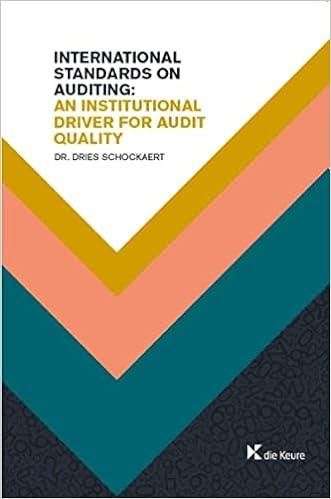Answered step by step
Verified Expert Solution
Question
1 Approved Answer
PLEASE WATCH ROUNDING REQUIRMENTS!!!! Gamboa's Tax Averaging. Gamboa, Incorporated, is a relatively new U.S.-based retailer of specialty fruits and vegetables. The firm is vertically integrated





PLEASE WATCH ROUNDING REQUIRMENTS!!!!
Gamboa's Tax Averaging. Gamboa, Incorporated, is a relatively new U.S.-based retailer of specialty fruits and vegetables. The firm is vertically integrated with fruit and vegetable-sourcing subsidiaries in Central America, and distribution outlets throughout the southeastern and northeastern regions of the United States. Gamboa's two Central American subsidiaries are in Belize and Costa Rica Maria Gamboa, the daughter of the firm's founder, is being groomed to take over the firm's financial management in the near future. Like many firms of Gamboa's size, it has not possessed a very high degree of sophistication in financial management simply out of time and cost considerations. Maria, however, has recently finished her MBA and is now attempting to put some specialized knowledge of U.S. taxation practices to work to save Gamboa money. Her first concern is tax averaging for foreign tax liabilities arising from the two Central American subsidiaries As shown in the popup window, 1, Costa Rican operations are slightly more profitable than Belize, which is particularly good since Costa Rica is a relatively low-tax country. Costa Rican corporate taxes are a flat 30%, and there are no withholding taxes imposed on dividends paid by foreign firms with operations there. Belize has a higher corporate income tax rate, 40%, and imposes a 10% withholding tax on all dividends distributed to foreign investors. The current U.S. corporate income tax rate is 35%. a. If Maria Gamboa assumes a 60% payout rate from each subsidiary, what are the additional taxes due on foreign-sourced income from Belize and Costa Rica individually? How much in additional U.S taxes would be due if Maria averaged the tax credits/liabilities of the two units? b. Keeping the payout rate from the Belize subsidiary at 60%, how should Maria change the payout rate of the Costa Rican subsidiary in order to most efficiently manage her total foreign tax bill? c. What is the minimum effective tax rate that Maria can achieve on her foreign-sourced income? a. If Maria Gamboa assumes a 60% payout rate from each subsidiary, calculate the additional taxes due or excess foreign tax credits on foreign-sourced income from Belize individually in the following table: (Round to the nearest dollar.) Gamboa's Tax Averaging. Gamboa, Incorporated, is a relatively new U.S.-based retailer of specialty fruits and vegetables. The firm is vertically integrated with fruit and vegetable-sourcing subsidiaries in Central America, and distribution outlets throughout the southeastern and northeastern regions of the United States. Gamboa's two Central American subsidiaries are in Belize and Costa Rica Maria Gamboa, the daughter of the firm's founder, is being groomed to take over the firm's financial management in the near future. Like many firms of Gamboa's size, it has not possessed a very high degree of sophistication in financial management simply out of time and cost considerations. Maria, however, has recently finished her MBA and is now attempting to put some specialized knowledge of U.S. taxation practices to work to save Gamboa money. Her first concern is tax averaging for foreign tax liabilities arising from the two Central American subsidiaries As shown in the popup window, 1, Costa Rican operations are slightly more profitable than Belize, which is particularly good since Costa Rica is a relatively low-tax country. Costa Rican corporate taxes are a flat 30%, and there are no withholding taxes imposed on dividends paid by foreign firms with operations there. Belize has a higher corporate income tax rate, 40%, and imposes a 10% withholding tax on all dividends distributed to foreign investors. The current U.S. corporate income tax rate is 35%. a. If Maria Gamboa assumes a 60% payout rate from each subsidiary, what are the additional taxes due on foreign-sourced income from Belize and Costa Rica individually? How much in additional U.S taxes would be due if Maria averaged the tax credits/liabilities of the two units? b. Keeping the payout rate from the Belize subsidiary at 60%, how should Maria change the payout rate of the Costa Rican subsidiary in order to most efficiently manage her total foreign tax bill? c. What is the minimum effective tax rate that Maria can achieve on her foreign-sourced income? a. If Maria Gamboa assumes a 60% payout rate from each subsidiary, calculate the additional taxes due or excess foreign tax credits on foreign-sourced income from Belize individually in the following table: (Round to the nearest dollar.)Step by Step Solution
There are 3 Steps involved in it
Step: 1

Get Instant Access to Expert-Tailored Solutions
See step-by-step solutions with expert insights and AI powered tools for academic success
Step: 2

Step: 3

Ace Your Homework with AI
Get the answers you need in no time with our AI-driven, step-by-step assistance
Get Started


